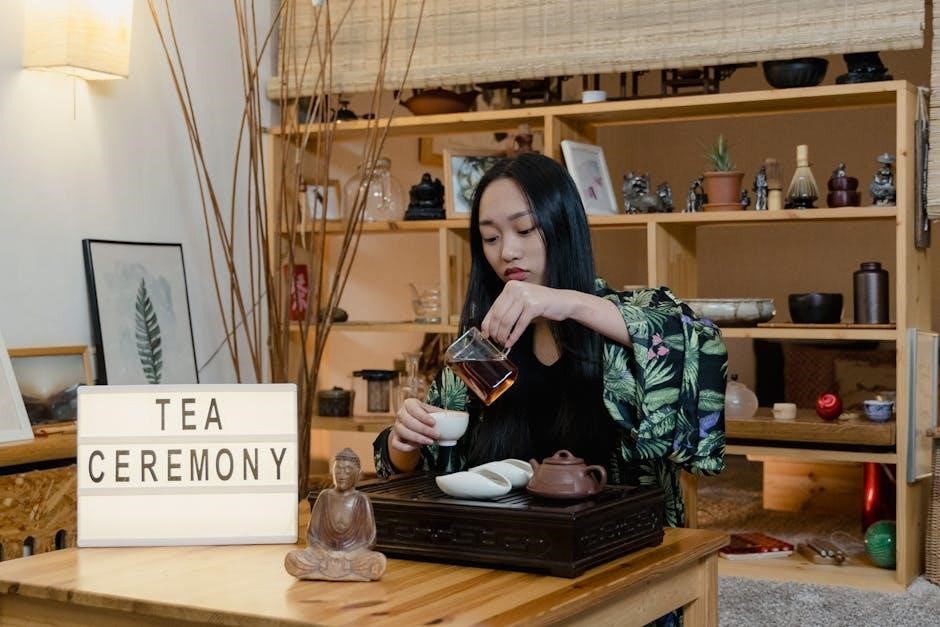
-
By:
- cierra
- No comment
fukien tea bonsai care guide
The Fukien Tea Bonsai, scientifically known as Carmona microphylla, is a popular, low-maintenance bonsai tree. Native to China, it’s admired for its compact form, evergreen leaves, and small white flowers. Perfect for beginners, this bonsai thrives indoors with proper care, offering a serene and elegant aesthetic to any space.
Overview of the Fukien Tea Bonsai
The Fukien Tea Bonsai (Carmona microphylla) is a compact, evergreen tree native to China. It’s highly valued for its small, rounded leaves, delicate white flowers, and ability to develop a knotted trunk over time. This species is ideal for indoor bonsai cultivation due to its tolerance of low light and consistent growth patterns, making it a popular choice for enthusiasts worldwide.
Why Choose Fukien Tea for Bonsai
The Fukien Tea bonsai is a top choice for beginners and experts alike due to its adaptability and forgiving nature. Its compact growth, small leaves, and ability to thrive indoors make it perfect for home environments. Additionally, it flowers frequently, adding aesthetic value, and can tolerate minor care mistakes, ensuring success even for those new to bonsai cultivation.

Lighting Requirements
The Fukien Tea Bonsai thrives in bright, indirect light, ideally placed near a window for optimal growth. Avoid direct sunlight to prevent leaf scorching.
Natural Light Needs
The Fukien Tea Bonsai prefers bright, indirect light for optimal growth. Placing it near a window with filtered sunlight ensures vibrant foliage. Avoid direct sunlight, as it can scorch leaves. Inadequate light may result in weak growth or fewer blooms.
Indoor vs. Outdoor Placement
The Fukien Tea Bonsai thrives indoors in temperate climates, requiring bright, indirect light. In warmer climates, it can be kept outdoors in shaded areas. Outdoor placement should avoid direct sunlight and ensure protection from extreme temperatures and winds for optimal health and growth.
Watering Techniques
Watering must be precise, keeping the soil moist but not soggy. Water when the top soil feels dry, typically once daily outdoors or every other day indoors;
How Often to Water
The Fukien Tea Bonsai requires careful watering. Water thoroughly when the top layer of soil feels dry to the touch, typically once daily in warm climates and every 2-3 days indoors. Avoid overwatering, as it can lead to root rot. Ensure the pot drains well to prevent waterlogged soil and root damage.
Signs of Overwatering and Underwatering
- Overwatering: Yellowing leaves, droopy branches, and root rot. If the soil stays soggy, the roots may decay, causing the tree to decline.
- Underwatering: Wilting leaves, dry soil, and slowed growth. Prolonged dryness can stress the tree, leading to leaf drop and poor health.

Temperature and Humidity
The Fukien Tea Bonsai prefers temperatures between 65-75°F and thrives in humid environments, typically above 50% humidity. Use a humidity tray if your climate is dry.
Optimal Temperature Range
The Fukien Tea Bonsai thrives in temperatures between 65-75°F (18-24°C). Avoid temperatures below 55°F (13°C) to prevent stress. Place near a south-facing window for warmth, but not near heating vents or fireplaces, as sudden temperature drops can harm the tree. Consistent temperatures promote healthy growth and flowering.
Maintaining Proper Humidity Levels
Maintaining proper humidity is crucial for the Fukien Tea Bonsai. Regular misting with distilled water prevents leaf drop. Use a humidity tray with water and pebbles to increase moisture. Grouping plants can also naturally boost humidity. Ensure the environment stays above 50% humidity, especially in dry climates, to keep your bonsai healthy and thriving.

Fertilization
Regular fertilization is essential for healthy growth. Use a balanced liquid fertilizer during the growing season (spring to autumn) for optimal nutrient absorption and vibrant foliage.
Best Fertilizers for Fukien Tea Bonsai
Use a balanced liquid fertilizer with a 20-20-20 formula during the growing season (spring to autumn). Dilute the fertilizer to half the recommended strength to avoid root burn. Organic options like fish emulsion or compost tea are also excellent choices. Feed your bonsai monthly to promote healthy growth, vibrant foliage, and frequent blooming. Proper fertilization ensures robust development and maintains the tree’s aesthetic appeal.
Fertilization Schedule
Fertilize your Fukien Tea Bonsai monthly during the growing season (spring to autumn). Use a balanced, water-soluble fertilizer at half the recommended strength to prevent root burn. Avoid fertilizing during冬季 when the tree is dormant. Apply the fertilizer after watering to ensure the soil is moist, promoting better nutrient absorption and healthy growth.

Pruning and Shaping
Prune your Fukien Tea Bonsai annually during the growing season to maintain shape and encourage growth. Use sharp tools for clean cuts, and trim back shoots to two-three leaves to promote compactness and aesthetics.
Pruning Tools and Techniques
Use bonsai scissors or concave cutters for precise trimming. Prune back shoots to two-three leaves annually to maintain shape and encourage branching. Remove dead leaves and excess growth to promote air circulation and light penetration. Wire can shape the trunk and branches, but apply gently to avoid scarring. Regular pruning ensures a balanced, healthy structure.
Shaping the Trunk and Branches
Shape the trunk and branches using aluminum or copper wire, bending carefully to avoid breaking. Older trees are more brittle, so wire gently. Check wires every few weeks to prevent bark damage. Prune unnecessary branches to enhance balance and aesthetics. Manual shaping can refine smaller twigs for a natural, artistic form, ensuring harmony and structural integrity for your bonsai.

Repotting
Repot your Fukien Tea Bonsai every 2-3 years in early spring. Prune the roots gently before transferring to fresh, well-draining soil. Water thoroughly after repotting to ensure soil settles properly and roots establish quickly.
When to Repot Your Fukien Tea Bonsai
Repot your Fukien Tea Bonsai every 2-3 years in early spring when the tree shows signs of being root-bound. Look for indicators like slowed growth, yellowing leaves, or roots growing out of the drainage holes. Spring repotting coincides with the tree’s natural growth cycle, ensuring minimal stress and promoting healthy development throughout the year.
Repotting Process and Soil Selection
Choose a well-draining soil mix for your Fukien Tea Bonsai, combining ingredients like akadama, peat moss, and sand. Repot every 2-3 years in early spring, gently removing the tree from its pot and trimming old roots. Place the tree in a slightly larger pot, ensuring proper drainage holes. Water thoroughly after repotting to settle the soil and maintain humidity for recovery.
Pest Control
Regular monitoring is essential to prevent infestations of spider mites and mealybugs, common pests that can harm the Fukien Tea Bonsai. Early detection ensures timely treatment.
Common Pests and How to Identify Them
Common pests affecting Fukien Tea Bonsai include spider mites, mealybugs, and scale. Spider mites create fine webbing on leaves, while mealybugs appear as white, cottony patches. Scale insects look like small, immobile brown or white bumps. These pests can cause yellowing leaves or sticky residues, signaling the need for prompt treatment to prevent further damage.
Organic and Chemical Pest Control Methods
Organic methods include neem oil, insecticidal soap, and horticultural oil to safely eliminate pests. For chemical control, systemic insecticides can target severe infestations. Always dilute chemicals as directed and apply in the evening to avoid leaf burn. Isolate treated trees to prevent cross-contamination and ensure thorough coverage for effective pest management and tree health preservation.

Propagation
Fukien Tea Bonsai can be propagated through air-layering or seed germination. Air-layering is the most effective method, while seeds are less commonly used but still viable. Success is highest in spring and summer when the tree is actively growing.
How to Propagate Fukien Tea Bonsai
Fukien Tea Bonsai propagation is best done via air-layering or seed germination. For air-layering, make a small incision near a node, apply rooting hormone, and wrap in moist moss. Roots develop within weeks. Seed propagation is less common but effective when started in well-draining soil under warm, humid conditions. Both methods require patience and consistent care for success.
Tips for Successful Propagation
Maintain high humidity around 70-80% and warm temperatures between 65-75°F. Provide indirect light to promote root development. Avoid overwatering to prevent rot. Use a well-draining soil mix and monitor progress daily. These conditions ensure successful propagation of your Fukien Tea Bonsai.
Seasonal Care
Adjust care routines seasonally. Protect from frost in winter, reduce watering, and avoid fertilizing. In warmer months, ensure ample humidity and light for healthy growth and flowering.
Spring and Summer Care
During spring and summer, the Fukien Tea Bonsai thrives in warmer temperatures and increased humidity. Water generously as the soil dries slightly, and fertilize regularly with a balanced fertilizer. Prune actively growing shoots to maintain shape and encourage healthy growth. Ensure plenty of natural light and humidity, especially in drier climates, to promote vibrant foliage and flowering.
Autumn and Winter Care
In autumn and winter, reduce watering as the Fukien Tea Bonsai becomes dormant. Fertilize sparingly, only during active growth periods. Protect the tree from cold temperatures below 65°F (18°C) and ensure moderate humidity. Provide bright, indirect light and avoid extreme temperature fluctuations to maintain health and prepare for spring growth.

Soil Mix
A well-draining soil mix, rich in organic matter, is essential for Fukien Tea Bonsai. Use a combination of peat moss, sand, and perlite for optimal root health.
Components of a Good Bonsai Soil
A good bonsai soil for Fukien Tea should include peat moss for moisture retention, sand for drainage, and perlite to prevent waterlogging. This mix ensures healthy root growth and prevents root rot. Avoid heavy garden soil, as it can trap water and harm the roots. The ideal mix is well-draining and slightly acidic, promoting robust health.
How to Prepare the Perfect Soil Mix
Combine 40% peat moss, 30% sand, and 30% perlite for optimal drainage and moisture retention. Sift each component to remove lumps and ensure even distribution. Mix thoroughly in a clean container until uniform. This blend prevents waterlogging, promotes root aeration, and maintains acidity, ideal for the Fukien Tea Bonsai. Sterilize the mix by oven-heating at 300°F (150°C) for 30 minutes to eliminate pests and fungi.

Placement and Display
Place your Fukien Tea Bonsai in bright, indirect light near a window. Avoid direct sunlight and drafts. Ideal temperatures are between 65-75°F, ensuring humidity and warmth for optimal health.
Best Locations for Your Fukien Tea Bonsai
Position your Fukien Tea Bonsai near a south-facing window for bright, indirect light. Avoid direct sunlight to prevent leaf scorch. In warm climates, it can thrive outdoors in shaded areas. Ensure good air circulation and maintain a consistent temperature between 65-75°F. A humid environment, such as a greenhouse or indoor space with a humidity tray, is ideal. This placement promotes healthy growth and flowering.
Decorative Tips for Displaying Your Bonsai
Enhance your space by placing your Fukien Tea Bonsai in a decorative pot that complements its natural beauty. Position it near a window for soft, indirect light and a serene view. Use a humidity tray with pebbles to add elegance and maintain moisture. Surround the base with moss or small stones for a polished look. Keep the area clean and clutter-free to highlight your bonsai as a focal point.
Proper care ensures your Fukien Tea Bonsai thrives, offering a serene and beautiful display that brings joy and tranquility to your home.
Final Tips for a Thriving Fukien Tea Bonsai
Keep your Fukien Tea Bonsai vibrant by maintaining consistent humidity, using a humidity tray, and adjusting care seasonally. Observe your tree’s responses and adapt watering and fertilizing accordingly. Regular misting and proper pruning will enhance its beauty and health, ensuring a stunning and thriving bonsai for years to come.
Common Mistakes to Avoid
Avoid overwatering, as it can lead to root rot, and underwatering, which causes leaf shriveling. Ensure your bonsai gets enough bright, indirect light but not direct sun. Prune sparingly to prevent stressing the tree, and avoid using poor-quality soil that lacks proper drainage. These common mistakes can hinder the health and beauty of your Fukien Tea Bonsai.